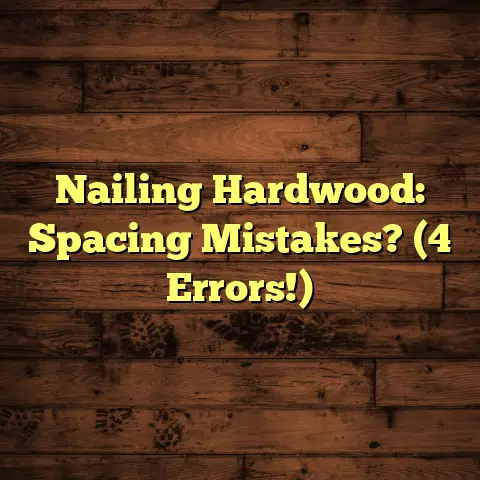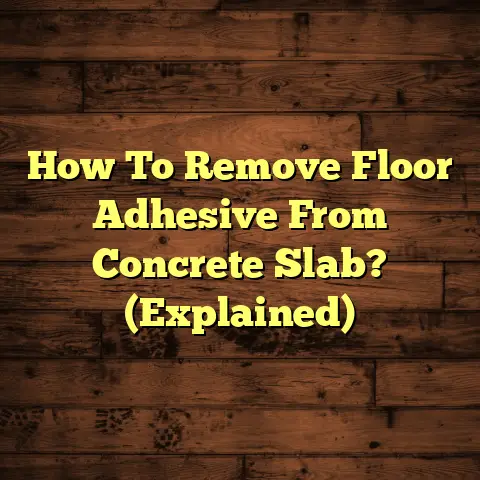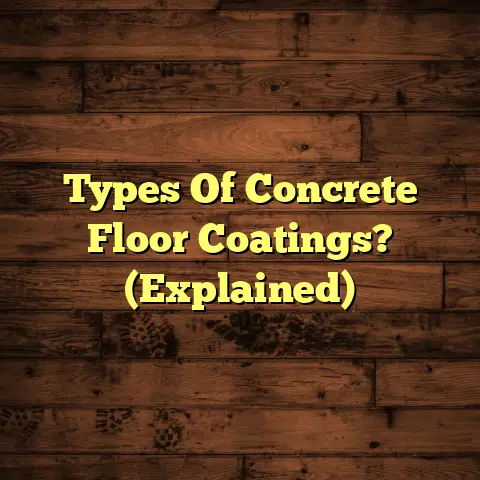Best Floor Cleaners After A Flood? (1 Urgent Fix!)
“In the aftermath of a flood, time is of the essence. The longer you wait to clean and restore your flooring, the greater the risk of mold and permanent damage.” – Mike Holmes, Professional Contractor & TV Host
Flooding can be a homeowner’s worst nightmare. It’s not just about the water; it’s about the damage it leaves behind. That’s why I’m here to guide you through the urgent need for effective floor cleaning solutions after a flood. I’ll show you how prompt action is crucial for safety and restoration. Let’s dive in!
Section 1: Understanding Flood Damage
Flood damage to floors goes beyond just water sitting on the surface. It’s about the water seeping into the materials, carrying contaminants with it. Think sewage, chemicals, and mud – all unwelcome guests in your home.
Different flooring types react differently to water exposure. Here’s a quick rundown:
- Hardwood: Warps, swells, and can develop mold quickly.
- Laminate: Prone to bubbling and delamination.
- Tile: Usually water-resistant, but grout can absorb contaminants.
- Carpet: A breeding ground for mold and bacteria.
Untreated flood damage is a ticking time bomb. Mold growth can start within 24-48 hours. This can compromise the structural integrity of your floors and pose serious health hazards.
Section 2: The Importance of Cleaning After a Flood
Why is immediate cleaning so vital? It’s about both your health and your home. Floodwater can contain harmful bacteria and pathogens, putting your family at risk.
Beyond the health concerns, immediate cleaning can save your flooring. The longer you wait, the more likely you are to face permanent damage and costly replacements.
Dealing with a flood is emotionally draining. A clean environment can help you feel more in control. It can also help you begin the recovery process.
Now, let’s talk about “The Urgent Fix” – a critical first step you absolutely must take immediately. This will give you a better chance of saving your floors.
Section 3: The Urgent Fix – Initial Steps to Take
Before you even think about cleaning products, safety first! Wear gloves, a mask, and protective eyewear. Floodwater can be nasty stuff.
Next, assess the damage. What type of flooring do you have? How deep did the water get? Are there any visible signs of mold?
Now for “The Urgent Fix”: Concrobium Mold Control.
I’ve used this product for years and I swear by it. It’s a broad-spectrum antimicrobial that effectively kills existing mold and prevents future growth.
Why Concrobium Mold Control?
- Ingredients: Contains a proprietary blend of trisodium phosphate and sodium carbonate.
- How it works: Penetrates and crushes mold spores at the root, preventing them from returning.
- Why it’s essential: It’s non-toxic, odorless, and safe for use on various surfaces.
How to Use Concrobium Mold Control as the Urgent Fix:
- Remove excess water: Use a wet/dry vacuum or mop to remove as much standing water as possible.
- Apply Concrobium: Spray Concrobium Mold Control liberally onto the affected areas.
- Allow to dry: Let the product dry completely. This may take 24-48 hours, depending on humidity.
- Reapply (if needed): If mold growth persists, reapply Concrobium Mold Control.
Important Note: Concrobium Mold Control is not a cleaner. It’s a mold remediation product. You’ll still need to clean your floors after using it.
Section 4: Evaluating Floor Cleaners
Now that you’ve tackled the mold issue, let’s talk about choosing the right floor cleaner. Here’s what to look for:
- Antibacterial properties: Kills harmful bacteria and pathogens.
- Effectiveness on your flooring type: Some cleaners are better suited for certain materials.
- Eco-friendliness: Look for biodegradable and non-toxic options.
- Ease of use: Consider the application method and drying time.
Certifications and Endorsements:
- EPA Safer Choice: Indicates that the product meets EPA’s criteria for safety and environmental friendliness.
- Green Seal: Certifies that the product meets rigorous environmental standards.
Avoid:
- Bleach: Can damage some flooring types and release harmful fumes when mixed with other chemicals.
- Ammonia: Can discolor certain surfaces and irritate your respiratory system.
Section 5: Top Floor Cleaners After a Flood
Based on my experience and research, here are my top recommendations for floor cleaners after a flood:
-
Microban Professional Disinfectant Spray:
- Description: A hospital-grade disinfectant that kills 99.9% of bacteria and viruses.
- Features: Prevents mold and mildew growth for up to 24 hours.
- Benefits: Provides long-lasting protection against harmful microorganisms.
- Ideal flooring type: Tile, laminate, and sealed hardwood.
- Expert Opinion: “Microban is a go-to for disinfecting surfaces after water damage. Its ability to prevent mold growth is a huge plus.” – Restoration Industry Association (RIA)
-
Simple Green Oxy Solve Total Outdoor Cleaner:
-
Description: A powerful cleaner that uses hydrogen peroxide to remove dirt and grime.
- Features: Biodegradable and non-toxic formula.
- Benefits: Safe for use around children and pets.
- Ideal flooring type: Concrete, tile, and outdoor surfaces.
- User Review: “I used this to clean my flooded patio, and it worked wonders! It removed all the dirt and stains without damaging the concrete.” – HomeDepot.com
-
Bona Hardwood Floor Cleaner:
-
Description: A pH-neutral cleaner specifically designed for hardwood floors.
- Features: Water-based formula that dries quickly and leaves no residue.
- Benefits: Safe for use on all unwaxed, polyurethane-finished wood floors.
- Ideal flooring type: Hardwood.
- Expert Opinion: “Bona is the gold standard for hardwood floor cleaning. It’s gentle yet effective, and it won’t damage your floors.” – National Wood Flooring Association (NWFA)
-
Puracy Natural Multi-Surface Cleaner:
-
Description: A plant-based cleaner that is safe for use on various surfaces.
- Features: Free of harsh chemicals, sulfates, and dyes.
- Benefits: Gentle on your skin and the environment.
- Ideal flooring type: Tile, laminate, and sealed hardwood.
- User Review: “I love this cleaner! It’s safe for my kids and pets, and it cleans my floors beautifully.” – Amazon.com
-
CLR Mold & Mildew Clear:
-
Description: A powerful cleaner that removes mold and mildew stains.
- Features: Contains bleach, so use with caution.
- Benefits: Effectively eliminates stubborn mold and mildew.
- Ideal flooring type: Tile and grout.
- Expert Opinion: “CLR Mold & Mildew Clear is a great option for tackling tough mold stains. Just be sure to follow the instructions carefully and wear protective gear.” – The Spruce
Table: Comparison of Top Floor Cleaners
| Product | Key Features | Ideal Flooring Type(s) | Pros | Cons |
|---|---|---|---|---|
| Microban Professional Disinfectant Spray | Kills 99.9% bacteria & viruses, prevents mold | Tile, Laminate, Sealed Hardwood | Long-lasting protection, hospital-grade disinfectant | Can have a strong odor, may not be suitable for all surfaces |
| Simple Green Oxy Solve Total Outdoor Cleaner | Biodegradable, non-toxic, hydrogen peroxide | Concrete, Tile, Outdoor Surfaces | Safe for kids & pets, effective on dirt & grime | May require scrubbing for tough stains, not ideal for delicate surfaces |
| Bona Hardwood Floor Cleaner | pH-neutral, water-based, quick-drying | Hardwood | Specifically designed for hardwood, leaves no residue | Only suitable for hardwood, may not remove heavy stains |
| Puracy Natural Multi-Surface Cleaner | Plant-based, free of harsh chemicals | Tile, Laminate, Sealed Hardwood | Gentle on skin & environment, safe for kids & pets | May not be as effective on heavy-duty cleaning |
| CLR Mold & Mildew Clear | Contains bleach, powerful mold remover | Tile, Grout | Effectively eliminates stubborn mold & mildew | Contains bleach, requires caution & protective gear |
Section 6: Step-by-Step Cleaning Process
Alright, let’s get down to the nitty-gritty. Here’s how to clean your floors after a flood:
-
Preparation:
- Remove all furniture and belongings from the affected area.
- Use a wet/dry vacuum or mop to remove any remaining standing water.
- Open windows and doors to ventilate the area.
-
Application:
- Follow the manufacturer’s instructions for your chosen cleaning product.
- Apply the cleaner evenly to the affected area.
- For carpet, use a carpet cleaner or shampooer.
-
Cleaning:
- Scrub the floors with a brush or mop.
- Pay special attention to areas with visible stains or mold growth.
- For carpet, use a carpet extractor to remove excess water and cleaner.
-
Sanitization:
- After cleaning, apply a disinfectant to kill any remaining bacteria.
- Allow the disinfectant to sit for the recommended time before wiping it up.
-
Drying:
- Use fans and dehumidifiers to dry the floors quickly.
- This will help prevent mold growth.
- For carpet, consider using a carpet dryer.
Example using Bona Hardwood Floor Cleaner on Hardwood Floors:
- Preparation: Remove furniture and sweep or vacuum loose debris.
- Application: Spray Bona Hardwood Floor Cleaner directly onto the floor in a manageable area (about 3×3 feet).
- Cleaning: Use a microfiber mop to clean the area, working with the grain of the wood.
- Drying: The cleaner should dry quickly on its own. If not, use a clean, dry microfiber mop to absorb any excess moisture.
- Repeat: Continue this process until the entire floor is cleaned.
Section 7: Post-Cleaning Care and Maintenance
Once your floors are clean, it’s important to take steps to maintain their integrity and prevent future issues.
- Regular cleaning: Sweep or vacuum your floors regularly to remove dirt and debris.
- Proper ventilation: Ensure that your home is well-ventilated to prevent moisture buildup.
- Humidity control: Use a dehumidifier to control humidity levels, especially in damp areas.
- Water damage prevention: Address any leaks or water damage promptly.
Preventive Measures:
- Install flood barriers: Consider installing flood barriers around your home’s perimeter.
- Elevate appliances: Elevate appliances like washing machines and water heaters to protect them from flooding.
- Improve drainage: Improve drainage around your home to prevent water from pooling near the foundation.
- Check insurance: Review your flood insurance policy to ensure that you have adequate coverage.
Conclusion
Flooding can be a devastating experience, but with the right cleaning products and methods, you can restore your floors and your peace of mind. Remember, acting quickly is crucial. Start with “The Urgent Fix” – Concrobium Mold Control – to prevent mold growth. Then, choose a floor cleaner that is appropriate for your flooring type and follow the steps outlined in this article.
Don’t let flood damage get the best of you. Take action today and safeguard your home!
I hope this article has been helpful. If you have any questions, feel free to reach out. I’m here to help you through this process.





